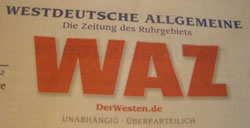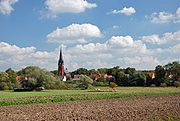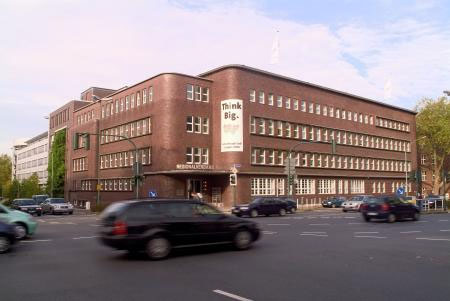
Seit Jahren habe ich die Denunziation der 80er Jahre klaglos ertragen. Habe Sendungen auf RTL (Rammeln, Titten, Lallen) mit Oliver Geissen gemieden aber nun habe ich in der Rundschau wieder einmal einen Text über die 80er gelesen und wieder einmal hatte ich das Gefühl, dieses Jahrzehnt zufällig verpasst zu haben. Das kann aber nicht sein, denn in die 80er fiel meine Jugend.
Suchbild: Auf dem Foto ist der Verfasser versteckt. Ausnahmsweise ohne schwarzes Hemd. Foto: Privat
Mit einem Rubrik-Würfel konnte ich ungefähr so viel anfangen wie ein Schimpansenjunges: Meine Versuche, innerhalb von 30 Sekunden auf dem Schulhof mit dem Ding einen Zufallstreffer zu landen scheiterten kläglich – und spielten sich im Übrigen Ende der 70er ab, als der angebliche Zauberwürfel auf den Schulhöfen des Landes reüssierte.
Die Sache mit dem Würfel ist aber auch nicht das Einzige, was mich an der ganzen, mittlerweile ja zum Glück zurückgehenden Publikationsflut zum Thema 80er irritierte. Meine Erinnerung – ja ich weiß, sie malt mit goldenen Lettern – ist eine gänzlich andere.
In meinem Freundeskreis trug kein Mensch bunte Jogginghosen. Wir trugen schwarze Jeans und dazu Lederjacken. Manchmal auch ein schwarzes Jackett. Eigentlich trugen wir immer nur schwarz: Schwarze Hemden, schwarze Lederschuhe. Dass man keine weißen Socken trägt, wusste eigentlich jeder.
Boris Becker fanden wir peinlich, Steffi „Die Nase“ Graf ebenfalls. Wir gingen in Filmnächte und schauten uns dort Godard, Truffaut und Achternbusch an. Und das taten eigentlich ziemlich viele – oft waren diese Filmnächte ausverkauft.
Klar, wir legten mehr Wert auf Kleidung. Der Unisex-Stil der uns verhassten 70er, diese gammligen Parkas und unförmigen Pullover, fanden sich in unseren Kleiderschränken nicht. Wir lasen Spex, waren links, aber mit einem gewaltigen Maß an Zynismus, machten Musik und spielten mit Videokameras herum. Über die Friedensbewegung machten wir bevorzugt herbe Scherze – ihre Protagonisten kamen vor allem aus dem Lager unserer Lehrer und mit deren Betroffenheit konnten wir nichts anfangen. Das Herumtragen der eigenen Gefühle, dieses widerwärtige „Das weiche Wasser bricht den Stein“-Gelaber empfanden wir als abstoßend. Wir entdeckten die Ironie, das freie Spiel mit Formen und Inhalten.
Wenn wir etwas waren, dann Realisten: Wir sahen sehr genau, dass die, die uns als unpolitisch denunzierten längst ihr Schäflein ins Trockene – sprich: Öffentlicher Dienst – gebracht hatten – und wir wussten, dass sie so jung waren, dass sie diese Jobs noch inne haben würden, wenn wir auf den Arbeitsmarkt kommen würden.
Also stürzten wir uns auf andere Bereiche: IT und Medien waren beliebte Brachen. Sozialwissenschaften, noch ein paar Jahre vorher angesagte Studiengänge, mieden wir wie der Teufel das Weihwasser und so fluteten wir die Informatik-, Kommunikationswissenschafts- oder Theater, Film und Fernsehwissenschafts- Studiengänge. Da wir im Gegensatz unserer jeder technische Innovation skeptisch gegenüberstehenden Vorgängergeneration keine Berührungsängste mit modernen Technologien hatten und deutlich pragmatischer waren, fanden wir schließlich unseren Platz – und das bevorzugt nicht im öffentlichen Dienst.
Und wenn ich mir meine Altersgenossen der 40+ Generation anschaue, dann zeichnet uns noch etwas aus: Ich kenne kaum einen, der mit Arroganz auf die nachfolgenden Generationen blickt. Diese Arroganz ist meiner Einschätzung nach auch kein Problem der 68er sondern derjenigen, die ihre Jugend in den 70er Jahren hatten und sich heute im Glanz der 68er sonnen, die sie nur als Kinder und Jugendliche an den schwarzweiß Fernsehern erlebten. Es ist schon blöd, wenn man zu jung für die Kommune 1 und den SDS war und einem nur noch der lächerliche KBWuchtig blieb.
Ich habe das ganze 80er-Bashing nie verstanden. Die 70er, deren Ausklang ich noch miterlebte, waren viel schlimmer – die Schmuddelästhetik, diese Plastikpullover und Hemden in denen man einen Stromschlag bekam und die immer zu warm oder zu kalt waren, die ganze Paranoia des Deutschen Herbstes und die nach 68er Depression – sorry, das war wirklich kein gutes Jahrzehnt. Ideen? Aufbruch? Fehlanzeige. Erst ganz zum Schluss brachte dieses Jahrzehnt zwei Ideen hervor, die erfolgreich waren und es bis in die heutige Zeit geschafft haben: Die Grünen und die taz. Beide setzten erst in den 80er durch.
Wir mochten Kohl nicht, der in einem Maß Scherze über sich ergehen lassen mussten, wie kein zweiter aber das Angebot der SPD war zum Gruseln: Vogel und Rau waren die Kandidaten der SPD jener Zeit. Stillstand pur. Uns war das egal: Bei simulierten Wahlen in den Politikkursen waren zumeist eh die Grünen die Partei mit dem meisten Stimmen. Für die SPD im Übrigen heute ein Problem: Als ganze Generation fehlen wir dieser Partei als Mitglieder und Wähler.
Vielleicht mögen sie uns deshalb nicht – wir lebten in einem recht langweiligen Jahrzehnt – und langweilige Zeiten sind für die Menschen immer gute Zeiten. Und wir wehren uns nicht: Ein Angriff auf die 68er und das Feuilleton. Wir zucken mit den Schultern und machen weiter. Die uns zugedachte Clownsrolle lassen wir über uns ergehen: Wir nehmen uns nicht so wichtig. Selbst dass ein nordhessischer Provinzbub wie Florian Ilies ein Buch über Teile von uns geschrieben hat, hat uns kaum berührt. Das bessere Buch kam eh aus den USA: Generation X von Douglas Coupland.
Also: Es war nicht alles Modern Talking in den 80er – sie waren ein ganz normales Jahrzehnt, höchstens ein wenig langweilig. Und ich könnte die Hosen und Hemden aus der damaligen Zeit noch immer ohne Scham tragen – wenn sie nicht am Bauch so spannen würden.








